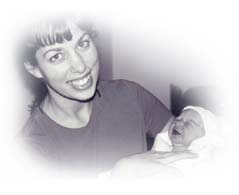Universal Newborn Hearing Screening
Frequently Ask Questions for Healthcare Providers
Please choose from the questions below for more information about Universal Newborn Hearing Screening / Early Hearing Detection & Intervention:
 What is the purpose of Universal Newborn Hearing Screening (UNHS)?
What is the purpose of Universal Newborn Hearing Screening (UNHS)?
The purpose of newborn hearing screening is to identify children who are at greater risk for hearing loss so that they may receive timely diagnostic and intervention services. Hearing screenings are NOT diagnostic evaluations. Screening tests identify a need for further diagnostic hearing evaluations.
What is the incidence of hearing loss in newborns?
Approximately 3 in 1,000 babies are born with a hearing loss. 1 in 1,000 babies are born deaf. 90% of children with hearing loss are born to hearing parents. The earlier that the hearing loss is identified, the sooner that intervention may begin.
What is the youngest age that a child’s hearing can effectively be tested?
Hearing can be assessed at any age, even the day that a child is born. Brainstem Auditory Evoked Response (BAER) and Evoked Otoacoustic Emissions (EOAE) evaluations are an effective and efficient means for identifying and quantifying hearing loss.
What are the differences between BAER and EOAE evaluations?
The BAER evaluation is conducted by placing electrodes on the child’s forehead and mastoid areas. Earphones are used to deliver sound to the child’s ear, either in the form of a click or pure tone stimulus. The BAER measures the neural response from the cochlear to the brainstem. It is a measure of neural synchrony along the auditory pathway.
The EOAE evaluation is performed by placing a small earphone into the child’s ear. Clicking sounds are introduced into the child’s ear. “Echo” responses, or emissions, are measured in healthy ears. EOAEs are acoustic signals generated by the cochlea, specifically, outer hair cells, in response to auditory stimulation. In response to click stimuli, EOAEs provide information over a broad frequency range (~500-6000Hz). Present EOAEs indicate that a child has no greater than a mild hearing loss.
Both tests are effective for newborn hearing screening.
 What are the referral rates for these tests?
What are the referral rates for these tests?
Referral rates have decreased significantly in the last few years. With recent advances in equipment, it is not unusual to have referral rates of 2%-3% for automated BAER and EOAE screenings.
What happens if a baby needs to be re-screened?
It is important for parents to understand that referral for a second screening does not necessarily mean their baby has a hearing loss. Information about hearing screening must be provided to parents in a professional, thoughtful, and sensitive manner. Parental stress should be minimized while conveying the importance of appropriate follow-up.
The most common reasons that a child would need a re-screen include otitis media with effusion, an ear canal blocked with debris, or a permanent hearing loss.
What is a pediatric diagnostic hearing evaluation?
The BAER or EOAE may be repeated. If necessary, a diagnostic BAER may also be performed in order to determine the child’s hearing thresholds. Pure tone stimuli are used in order to determine hearing thresholds at specific frequencies.
What if a hearing loss is identified?
The goal of universal newborn hearing screening is to identify children with hearing loss early, in order to initiate intervention services by six months of age. Intervention services include properly fitted amplification, family focused communication strategies, early childhood services, and parental support groups.
 Why not wait until babies are older?
Why not wait until babies are older?
The critical years for the acquisition of speech and language are 0-3, making early identification crucial. Children with hearing loss, even those with mild to moderate losses, who are identified later in life, may have social-emotional difficulties as well as language and educational delays. Parent-child relationships are compromised when there is an unrecognized difference in hearing status between parent and child. The earlier that a hearing loss is identified and intervention begins, the more natural parent-child communication may become. This enhances parent-child bonding and the child’s social-emotional, cognitive, and language development.
Why screen all newborns? Why not just those identified as high risk by the Joint Committee on Infant Hearing?
The Joint Committee’s high-risk criterion include but are not limited to:
- Any illness or condition requiring admission to a NICU for greater than or equal to 48 hours,
- A syndrome associated with congenital or progressive hearing loss,
- A family history of permanent childhood hearing loss,
- Craniofacial anomalies,
- Bacterial meningitis,
- Severe hyperbilirubinemia,
- Head trauma,
- Recurrent otitis media, and
- Parental concern
However, over 50% of children with congenital hearing loss don’t meet any of these risk criteria, and would not be identified if the high-risk register was used as the only criterion for screening newborns.
If a child passes the newborn screen, when should they be tested again?
Children with any risk factors for progressive hearing loss should continue to have their hearing monitored. If speech-languages milestones are delayed, the child’s hearing should be re-evaluated. Also, if the child’s parent is concerned, re-evaluation is usually appropriate.
 How is hearing tested in older babies?
How is hearing tested in older babies?
As children grow, the testing techniques also change. BAER and EOAEs are commonly used until a child is old enough to provide behavioral responses to sound, usually around 7-8 months of age. At this time, behavioral tests such as Visual Reinforcement Audiometry (VRA) are employed.
What can you do?
As the child’s primary healthcare provider, parents rely on and respect your judgment. Your encouragement and recommendations to families regarding follow-up for newborns that need to be re-screened is vital.
In addition, you are the professional best able to monitor the child’s speech and language development, and are entrusted to refer for a hearing loss evaluation when you or the parents have concerns.
If you have any questions or would like more information regarding newborn hearing screening, please click here for additional resources.
